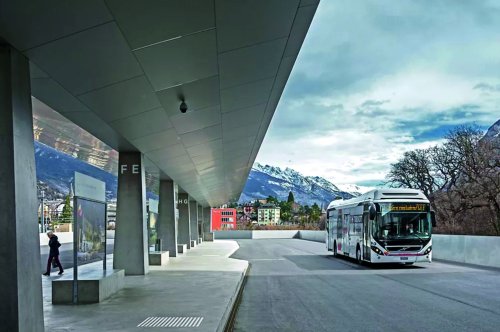SWITZERLAND
The city of Sierre in Switzerland has tailored it full hybrid fleet to all of its city bus routes using an application of geofencing technology. The city says that using Volvo’s Environmental Zones solution has resulted in the buses spending half of their operating time in quiet, emission-free electric mode.
Located in the scenic, mountainous Valais region of Switzerland, the city of Sierre places great importance on sustainability and air quality. Operator Bus du Soleil has been running services in the city for the 20 years. In 2015, it renewed its fleet with four Volvo 7900 full hybrids to meet new environmental requirements. In 2020 it took a further step towards more sustainable public transport by implementing Volvo’s zone management services.
Nicolas Melly, Director of Bus du Soleil, said: “The optimisation resulted in part-time electric performance, allowing us to further reduce greenhouse gas emissions from our fleet, as well as to make the buses quieter for both passengers and pedestrians. As there is no need for battery charging infrastructure, this makes the enhanced hybrids an excellent bridging technology on the path to full electrification.”
At the time, the application of geofencing technology, designed to boost the performance of full hybrid Volvo buses, had already been successfully developed and trialled in Luxembourg, but Sierre is the first city to apply the technology to all of its bus routes.
Volvo explained that an analysis of the routes was carried out to determine characteristics such as speed profile, distribution of energy recovery and noise impact, which was then used to determine the optimal locations for additional electric drive. A set of environmental zones was then created to tailor the overall performance of the buses, including the default decision-making process of the, such as selecting electric departure from bus stops, with additional pre-defined locations for electric drive.
Volvo said that since its implementation, there has been a drop in energy consumption and CO2 emissions on all the routes in Sierre have been reduced by 10%, equating to around 35 tonnes per year per vehicle in comparison to a diesel bus.
The average electric operating time of each bus is now 50%, although the driving distance on electric power alone varies by route. According to Volvo, in Sierre this ranges from 22% on the flattest route to 50% on the hilliest route and on a typical day, each bus can cover up to 60km in electric mode, an average of 30% of its mileage.
Nicolas said: “Overall, the upgrade of our hybrids with the latest technologies has exceeded our expectations. Not only have we lowered our carbon footprint, we have also substantially increased quiet electric drive where it counts for the people that live and work here – at bus stops, on busy streets and in noise-sensitive residential areas.”
Jean-Pierre Roemer of Volvo Buses Switzerland added: “In almost any urban area, the opportunity to optimise where buses can drive in extended electric mode is an attractive proposition. It is exactly what we have provided in Sierre and I am delighted with the results.”
Bus du Soleil employs 10 staff, and runs a fleet of five buses including the four 7900 hybrids. There are a total of 22 environmental zones, the longest of which is 1.1km.


